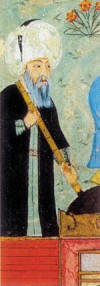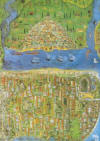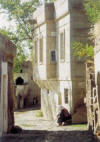The
Ottoman Architecture
Ottoman architecture is the architecture of the Ottoman Empire,
which emerged in northwestern Anatolia in the 13th century. The
architecture of the empire developed from Turkish and the earlier Seljuk
architecture, with influences from Byzantine and Iranian architecture
along with architectural traditions of the Balkans and other parts of
Middle East.The classical architecture of the Ottoman Empire was a
mixture of native Turkish tradition and influences from Hagia Sophia.
One of the best representatives of this period is Mimar Sinan, whose
works include Süleymaniye Mosque. Beginning in the 18th century, Ottoman
architecture was influenced by the Baroque architecture in Western
Europe. Nuruosmaniye Mosque is one of the surviving examples from this
period. The last Ottoman period saw more influences from Western Europe,
brought in by architects such those from the Balyan family. This period
also saw the development of a new architectural style called neo-Ottoman
or Ottoman revivalism, also known as the First National Architectural
Movement, by architechs such as Mimar Kemaleddin and Vedat Tek.
Today, one finds remnants of Ottoman architecture in certain parts of
the former empire's territories under decay.
The Ottoman Empire
The Ottoman Empire was established in 1299, and it grew steadily,
putting an end to the Byzantine Empire in 1453. It reached its peak by
the end of the 16th century. The Empire included a diversity of
cultures, which were preserved locally, while its general character
remained eastern and Ottoman. After its conquest, Istanbul became the
artistic and cultural centre of the empire, diffusing its influence
across its various provinces in proportion to the relations it
maintained with them.
Eastern influences, especially those brought back from the campaigns
waged in the East by Sultan Selim I and his successor Süleyman the
Magnificent, also known as Kanuni (Law-Giver)- were integrated into the
vast and mature Ottoman culture, as had previously been the case with
Byzantine architecture. The most brilliant period of Ottoman
civilisation was during the 16th and 17th centuries, during which time
the most famous names achieved great feats in fields of science,
administration and in the arts.
This was due in great part to the empire's economic power, but also to a
well organised and stable administration, the prevalence of justice and
fairness, as well as a rational world view.
In Sinan's time, the Islamic institution of the vakıf or waqf, a kind pf
pious charitable foundation, was highly developed. It was through the
establishment of such foundations and in a charitable spirit that
sultans and members of their families, as well as viziers (ministers),
and pashas (generals) contributed funds for the establishment of many
public works. The wealthy also followed their examples. We can say that
practically all the architectural works of that time were built by
vakıfs, but it was still the State which provided the revenues for the
donors.
Indeed many important State resources were entrusted to prominent people
through the institution of the "mülk". And this made it possible for
viziers such as Rüstem Paşa and Sokullu Mehmet Paşa (we shall henceforth
use Turkish spelling for Turkish names) and princesses of the Imperial
Harem, such as Hürrem Sultan and Mihrimah Sultan (the word Sultan placed
after a woman's name means princess), to order numerous vakıf projects.
During the reign of Sultan Süleyman the Magnificent a most active period
was witnessed in the Empire in terms of the construction of public
works, and Sinan was most fortunate to have the post of chief architect
at a time when resources were so abundant. The vakıf system not only
permitted the building of such works, it also ensured their maintenance,
which made it possible for them to survive until this day. Funds for
their maintenance were provided by the revenues obtained from shops,
commercial buildings and kervansarays (hostels for merchants and
travellers), hamams (public baths), bedestens or mills, all constructed
next to monuments built by donations. The administration of these
revenues was entrusted to the vakıfs. The establishment of vakıfs was
always encouraged, and many facilities were provided for that purpose.
The founder of the vakıf could specify how it was to be used through its
administrative statutes or vakfiye. Such freedom of choice brought a
significant plurality to Ottoman social and cultural life. As for other
works which were directly undertaken by the State, they consisted of
military establishments, roads and bridges, as well as palaces and
buildings.
Ottoman Sultans of the 16th century were not only patrons of the arts
but were also directly involved in their administration. They
established workshops which specialized in all kinds of crafts. Artists
and artisans of the Palace (the Ehl-i Hiref), ranging from painters to
calligraphers, from carpenters to jewellers, were trained at these
establishments, where they were then able to contribute to the art of
the Empire. The wages earned by these artists were higher than those of
civil servants working at the Palace. This explains why architectural
works were built with such care.

The Imperial Corps of Architects
Ottoman documents reveal that there was a special architectural
institution attached to the palace called the Hassa Mimarlar Ocağı
(Imperial Corps of Architects). The date of the founding of this
institution is not clear but we do know that it was already in existence
before 1525. It was linked to the Şehremini (an individual responsible
for the financing, purchasing and administrative activities related to
the construction of buildings). The Hassa Chief architect was in charge
of its administration. The first chief architect is believed to have
been Acem Alisi (Alaüddin). The chief architect had as his assistants
the water supply director, the chief of apprentices, the chief
limeworker, the warehouse director, the first secretary of the
warehouse, the first architect, the deputy architect, the director of
repairs, and many master architects, qualified builders, foreman and
artisans, as well as officers in charge of monitoring their activities.
The institution was in charge of practically everything related to the
empire's civil engineering, architecture and urban development
activities: water supply, sewerage system, roads and pavements, building
regulations, permits and their control, as well as fire prevention, the
activities of architects, foremen and superintendents and their wages,
the standardisation of building materials and their quality and price
control.

It was also in charge
of designing, erecting, maintaining and repairing buildings belonging to
the imperial family, high-ranking state officials, and of appointing
architects, foremen and superintendents for these tasks. In addition, it
was responsible for the building of bridges, forts and other military
works in times of war. Finally, it functioned as an educational
institution, being in charge of the training of the most talented youths
among those recruited by the "devşirme" (levy of Christian children for
the Jannisary Corps and other State services).
The plans for building projects were first in the form of sketches or
models and then they were submitted to the palace together with their
cost estimates. Before construction began, someone was appointed to be
in charge of the building, who would also be responsible for the
building materials and workers, and who would regularly note down the
expenses incurred. For important projects, the palace would be directly
approached for the procurement of materials and staff. In the provinces,
the "kadıs", who functioned both as judges and mayors, would inform the
palace of their building requirements and the latter would then give
orders to the chief architect. In the construction of imperial
buildings, young devşirme recruits, palace artisans (Ehl-i Hiref), hired
laborers and foremasters worked along with prisoners of war and
convicts. Both Muslims and Christians would be employed. If necessary,
architects would be sent to different provinces and sometimes abroad.
The Muslim rulers of India are known to have asked the Ottoman Sultans
to send them architects, and some of Sinan's students were indeed sent
there.
It is believed that the Imperial Corps of Architects became masters
during Sinan's time when it was restructured in order to handle the then
frantic building activity. The institution lasted for some 350 years,
until it was integrated into the municipality in 1831.

Ottoman Architecture Prior to Sinan
In order to get a better understanding of Sinan's architectural
achievements, we must dwell briefly on the architectural developments
that preceded them. Sinan's greatest contribution lies in his
innovations regarding the use of the dome. With the exception of certain
tombs, domes did not cover the whole area of buildings in the Islamic
world, rather they served to enhance buildings. The Ottomans virtually
identified their mosques with domes, trying out every possible variant
of the form. The role of Saint Sophia in this context cannot be denied.
The function of the dome was moreover not limited to covering a given
area, it became a key element in the design of a mosque.
Single, multiple, plural-based or multi-functional inverted T-shaped
domed mosques and their domed tombs, departing from the old kümbet form,
were already a typical Ottoman style at the time when Bursa was the
first capital of the empire (1326), along with domed medreses
(theological seminaries), and domed hamams.
The Bursa style continued for some time after the city of Edirne was
proclaimed the second capital of the Empire in 1368, but the Üç Şerefeli
Mosque, built in Edirne by Murad II in 1447, is considered an innovation
in the design of mosques because it introduced a plan which was to be
amply developed later.
Innovative features like the hexagonal structure supporting its dome,
its porticoed courtyard and its four minarets, do indeed impart a
character to the mosque not typical of the period.
After the conquest of Istanbul (1453), the Saint Sophia Basilica, which
was much admired by the Ottomans, became a focus of interest for Turkish
architects, who practically idolized it. The Fatih (Conqueror) Külliye
(a religious complex) was completed in 1471 under the reign of Mehmet
II. With its sixteen medreses, its location and composition, this
monumental complex put a Turkish stamp on the city. A semidome was added
to the main dome of the original Fatih mosque, probably being influenced
by the architecture of Saint Sophia, which brought the concept into
Ottoman architecture. The old Fatih mosque was still standing in Sinan's
time. It was to be destroyed in the 1776 earthquake. Also interesting is
the Beyazid II Külliye in Edirne (1488), with pendentives supporting a
20m diameter dome and the design of its hospital. The interior of the
mosque is dominated by a single dome. The side walls have windows and
the dome supports are almost unnoticeable. This was the prototype for
the Mihrimah Mosque in Edirnekapı, which Sinan was to build some 80
years later. The Beyazid II Mosque in Istanbul (1506) is an improved
version of the old Fatih Mosque. The influence of Saint Sophia may also
be felt here, but must not be considered to be a simple copy.
The works mentioned above indicate that Ottoman architecture was already
developed by the time Sinan appeared.


The Works of Sinan
According to the sources available on Sinan's career, he produced more
than four hundred works. It may be safer to say that these works were
built or restored during his lifetime. We shall not attempt to describe
each and every one of Sinan's works but rather focus on the most
important ones, as well as those which are most representative of his
art.
Religious complexes (Külliyes) had diverse public service functions, the
most important of which was religious. The main building of the complex
was the mosque, followed by the medrese or theological seminary. The
complex would usually also include the following: a soup kitchen or
refectory, guesthouse, hospital, school, public bath, fountain, water
distribution kiosk and shops. The tomb of the person who had ordered the
project would generally be situated within the complex. Külliyes
situated on the main caravan routes would include in addition to the
kervansaray, a prayer hall, hamam, soup kitchen, shops and stables. The
külliyes were powerful social poles, and the fact that they were
conceived as vakıfs ensured their continuity. The activities carried out
in these complexes considerably stimulated the urban development of the
areas in which they were built. Therefore, many külliyes were built in
newly settled areas in order to help in their development. The duties
and rights of each külliye were specified in detail in the foundation's
charter and the people in charge of the vakıf implemented the
regulations in the charter.
The külliyes designed by Sinan were exquisitely conceived, be it from
the standpoint of the site chosen, integration with rough terrain, or as
regards harmony achieved with the city's general skyline. Most of
Sinans structures are situated on hilltops or along the seashore where
they can be easily seen. They strike the eye as one approaches the city,
constituting an inseparable part of its silhouette. The choice of the
site is not only related to the Külliye's appearance from afar, but also
to the view one has of the city from inside the complex, a view enhanced
with the spectacle of the sea offered by the shores of the Bosphorus and
Golden Horn. Sinan was especially skilled in adopting his design to
sloping terrains. Solving such problems seems to have been like some
sort of entertaining crossword puzzle for him. The buildings which
constitute the külliye are very skilfully situated at levels
corresponding to their function and importance. The final result is a
well graded complex offering a fine appearance visible from afar, and
forming an organic whole dominated by the mosque.
References and External
Links
- Sinan, The Architect and his
Works, by Prof. Dr. Reha Günay, translated by Ali Ottoman
-
Turkish Art &
Architecture
- Architect Sinan, Wikipedia
(English)
- Mimar Sinan, Wikipedia (French)
- Sinan'a Saygi

TransAnatolie Tour
|